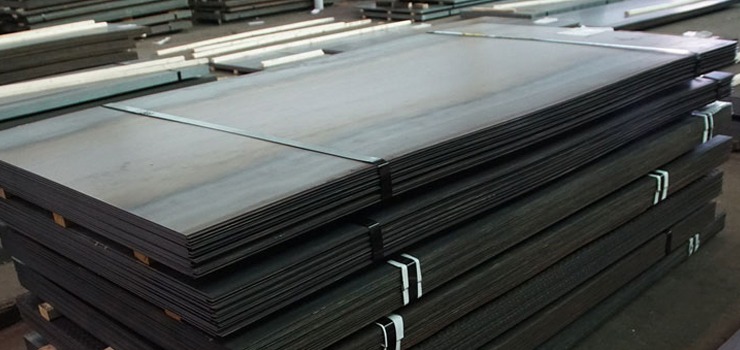Role of ASTM SA 517 Grade F Plates in Pressure Vessel Manufacturing

In the world of industrial manufacturing, pressure vessels play a crucial role in safely storing gases and liquids under high pressure. These vessels are vital in industries such as oil & gas, chemical processing, power generation, and even food processing. For such critical applications, material selection becomes the foundation of safety, performance, and longevity. One of the most reliable materials used in this space is ASTM SA 517 Grade F Plates.
In this blog, we will explore the importance, properties, applications, and manufacturing guidelines of ASTM SA 517 Grade F Plates, focusing specifically on their role in pressure vessel manufacturing.
What Are ASTM SA 517 Grade F Plates?
ASTM SA 517 Grade F is a pressure vessel steel plate specification covered under ASTM A517 standard, primarily intended for high-strength and high-temperature services. These plates are quenched and tempered, giving them exceptional strength and toughness.
-
ASTM SA 517 Grade F Plates are alloy steel plates.
-
They are used primarily in the fabrication of pressure vessels and boilers operating under high-pressure environments.
-
These plates are heat-treated by quenching and tempering to improve mechanical strength and impact resistance.
Why Material Selection Matters in Pressure Vessel Manufacturing
Before diving deeper into the features of SA 517 Gr F, it’s essential to understand why material selection is such a big deal in this industry:
-
Safety: Pressure vessels handle volatile and pressurized contents. A failure could lead to explosions or toxic leaks.
-
Durability: Materials must endure temperature fluctuations, corrosive environments, and mechanical stress.
-
Compliance: Many industrial applications require strict adherence to ASME and ASTM standards.
This is why ASTM SA 517 Grade F Plates have become a go-to choice for pressure vessel fabricators.
Mechanical Properties of ASTM SA 517 Grade F Plates
One of the biggest advantages of SA 517 Gr F steel plates is their superior mechanical properties, which make them ideal for high-pressure environments.
| Property | Value |
|---|---|
| Tensile Strength | 100-130 ksi (690-895 MPa) |
| Yield Strength | Min 90 ksi (620 MPa) |
| Elongation | Min 18% in 2 inches |
| Hardness | 235-293 HBW |
| Impact Resistance | Excellent (even at low temperatures) |
These mechanical properties are achieved through controlled quenching and tempering, which enhance the material’s internal structure for added strength and resistance.
Chemical Composition of SA 517 Grade F Steel
The chemical elements used in these plates contribute significantly to their performance. Here’s a quick overview:
| Element | Composition (%) |
|---|---|
| Carbon (C) | 0.10 – 0.20 |
| Manganese (Mn) | 0.85 – 1.30 |
| Silicon (Si) | 0.13 – 0.45 |
| Chromium (Cr) | 0.80 – 1.15 |
| Molybdenum (Mo) | 0.45 – 0.65 |
| Phosphorus (P) | ≤ 0.025 |
| Sulfur (S) | ≤ 0.025 |
This blend of alloying elements offers an excellent combination of strength, hardness, and corrosion resistance.
Key Benefits of Using ASTM SA 517 Grade F Plates
1. Exceptional Strength-to-Weight Ratio
These plates offer high tensile and yield strength, making them suitable for pressure vessels where both strength and weight reduction are critical.
2. Excellent Impact Resistance
SA 517 Gr F Plates are known for their ability to withstand impact at low temperatures, a crucial requirement for pressure vessels operating in cold climates or cryogenic conditions.
3. Superior Weldability
Despite being high-strength steel, these plates are readily weldable with standard welding procedures when preheating and post-weld heat treatments are followed.
4. High Temperature Resistance
Thanks to their alloy composition and heat treatment process, these plates perform well even in elevated temperature environments.
How SA 517 Grade F Plates Are Used in Pressure Vessel Manufacturing
1. Storage Tanks for Petrochemicals
Petrochemical processing involves storing hazardous substances under pressure. ASTM SA 517 Grade F Plates are used to construct the shell and heads of these tanks to ensure durability and safety.
2. Boilers and Steam Drums
In power plants and steam generation units, boilers operate under very high pressures. SA 517 Gr F steel offers the necessary tensile strength and temperature endurance required in these systems.
3. Cryogenic Vessels
Thanks to their impact resistance at low temperatures, these plates are also utilized in cryogenic pressure vessels that store liquefied gases like LNG or nitrogen.
4. Offshore Drilling Rigs
In marine and offshore environments, corrosion and mechanical stress are constant threats. SA 517 Grade F plates are used to build pressure vessels that can withstand both.
Heat Treatment Guidelines for SA 517 Gr F
These plates undergo quenching and tempering to meet ASTM specifications. The typical process involves:
-
Quenching – The plate is heated to around 900–950°C and then rapidly cooled in water or oil.
-
Tempering – Followed by reheating to around 600–700°C and holding for a specified time before cooling.
Proper heat treatment enhances strength, ductility, and impact toughness, making them suitable for demanding applications.
Welding Recommendations for ASTM SA 517 Grade F Plates
While SA 517 Gr F has good weldability, careful welding practices must be followed to prevent cracking or loss of mechanical properties.
Pre-Welding Considerations:
-
Preheat the material to around 200–300°C depending on thickness.
-
Use low-hydrogen electrodes to reduce the risk of hydrogen-induced cracking.
Post-Welding Heat Treatment:
-
A stress-relieving process may be required to restore toughness.
-
Proper cooling cycles must be observed to maintain microstructure.
Welding procedures must be qualified per ASME Section IX or relevant codes, especially for pressure-bound applications.
Comparison with Other Grades of A517
| Grade | Main Difference | Typical Use |
|---|---|---|
| Grade A | Lower yield strength | Light pressure vessels |
| Grade E | Similar strength but better notch toughness | Vessels in cold climates |
| Grade F | High strength and impact resistance | High-pressure, high-temperature vessels |
Among all grades, ASTM SA 517 Grade F offers a well-balanced combination of strength, weldability, and toughness.
Standards & Certifications for SA 517 Gr F Plates
To ensure quality and compliance, ASTM SA 517 Grade F Plates must be certified to:
-
ASTM A517 / ASME SA517 standards
-
EN 10028 (optional for EU markets)
-
ISO 9001:2015 quality systems
-
NACE MR0175 (for sour service, if applicable)
Always ensure that the material is mill-certified and tested for ultrasonic, impact, and tensile strength before use.
Industries That Rely on SA 517 Grade F Steel Plates
-
Oil & Gas
-
Power Generation
-
Chemical Processing
-
Petrochemical Refineries
-
Marine and Offshore
-
Cryogenics & Gas Processing
These industries require robust, reliable, and code-compliant steel plates, which is why ASTM SA 517 Grade F is widely adopted.
Conclusion
The manufacturing of pressure vessels is not just about shapes and sizes—it’s about choosing materials that can withstand extreme environments without failing. In this context, ASTM SA 517 Grade F Plates stand out as a high-performance, reliable, and standards-compliant solution. Whether it’s petrochemical storage, offshore oil rigs, resources like theglobalnewz.com highlight the critical need for cryogenic containers, or power plant boilers, these plates offer the strength, durability, and safety required to perform under pressure.



